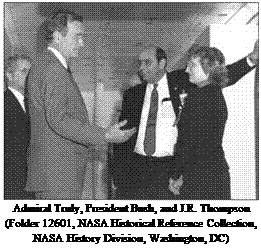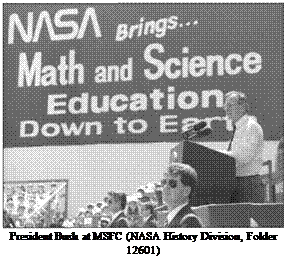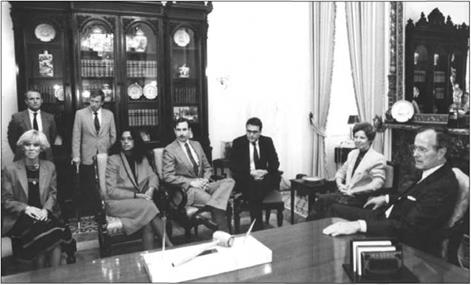In September 1991, two years of White House frustration with Admiral Truly came to ahead when NASA Deputy Administrator J. R. Thompson tendered his resignation. The job was a presidential appointment and provided the Space Council with an opportunity to select someone who would support President Bush’s vision for the future. Mark Albrecht was responsible for making the selection, but was surprised to find that no one would take the position as long as Admiral Truly remained administrator. Despite being an outspoken critic of the administrator, Albrecht was surprised by how widespread anti-Truly feelings were. After briefing Vice President Quayle regarding the status of the search, he was asked to assess whether there was support for Truly’s removal. In early December, Quayle and Albrecht met with three former NASA administrators—Jim Beggs, Thomas Paine, and Jim Fletcher. During the course of the meeting each of the three reiterated a common message—Truly had to go.[328] [329]
After conferring with President Bush, Vice President Quayle summoned Admiral Truly to the White House and requested that he step aside as administrator. He offered to appoint Truly to any open ambassadorship in the world in exchange for his resignation. The administrator said he would consider the proposal. A few days later, however, he sent a message to the Quayle stating he would not resign. “Then he went into utter radio silence for a week, maybe two weeks,” remembers a Quayle staffer. Then, out of the blue, Albrecht received a phone call from the newly appointed White House Chief of Staff, Samuel Skinner. Apparently Truly had made an appointment with Skinner, in an attempt to plead his case. Quayle and Albrecht were outraged at the administrator’s audacity. It was even more startling, however, when Truly again refused to resign when Skinner reiterated Quayle’s earlier resignation request. “I want to hear it from the President’s lips,” Truly told Skinner. By this
time it was early February 1992.[330] [331]

 On 10 February, at about five o’clock in the afternoon, Truly was once again summoned to the White House—this time to the Oval Office. After a half hour with President Bush, he finally agreed to submit his resignation. As with most other major space policy decisions made by the Bush administration, there were mixed reactions to the decision to fire Admiral Truly. Many space experts were not terribly surprised by the White House move. John Logsdon (a newly appointed member of the Vice President’s Space Advisory Board) told The Washington Post that Truly “did an extremely valuable job in getting the Shuttles flying again, and restoring a sense of integrity to the agency… [however], Truly’s vision of the future was not compatible with the realities of the world.” Others were troubled by the signal this forced resignation sent regarding the future course of the space program. Senator A1 Gore was quoted saying, “I view this as a very troubling sign that.. .Quayle’s Space Council may have forced Admiral Truly to leave this job because of the [Space Council’s] insistence on running NASA from the Vice President’s office.”®
On 10 February, at about five o’clock in the afternoon, Truly was once again summoned to the White House—this time to the Oval Office. After a half hour with President Bush, he finally agreed to submit his resignation. As with most other major space policy decisions made by the Bush administration, there were mixed reactions to the decision to fire Admiral Truly. Many space experts were not terribly surprised by the White House move. John Logsdon (a newly appointed member of the Vice President’s Space Advisory Board) told The Washington Post that Truly “did an extremely valuable job in getting the Shuttles flying again, and restoring a sense of integrity to the agency… [however], Truly’s vision of the future was not compatible with the realities of the world.” Others were troubled by the signal this forced resignation sent regarding the future course of the space program. Senator A1 Gore was quoted saying, “I view this as a very troubling sign that.. .Quayle’s Space Council may have forced Admiral Truly to leave this job because of the [Space Council’s] insistence on running NASA from the Vice President’s office.”®
The day after Truly stepped down, President Bush stopped Mark Albrecht in the hallway as the former was on his way to a meeting. “Your job,” the President told him, “is to get me the best NASA Administrator in history, and do it before Truly’s resignation is effective.” Truly was to resign effective 1 April, which meant that Albrecht only had 45 days to have a replacement in place—which would mean a faster confirmation process than anyone during the entire course of the Bush presidency. Within a few days, Albrecht had compiled a short list of potential can
didates. Everyone on the list was well known within the space policy community, except for one name that quickly rose to the top of the heap. Dan Goldin was a relatively obscure middle manager at TRW who a few years earlier had pitched an idea for a smaller, cheaper version of the NASA Earth Observation System (EOS). A mechanical engineer who received his B. S. from City College of New York in 1962, Goldin’s first job after graduating was at NASA’s Lewis Research Center—where he dreamed of sending humans to Mars. Within five years, however, he left the agency to join TRW and work on classified defense programs. He was a rising star at the company, and in the mid-1980s became heavily engaged in the nations top – priority Strategic Defense Initiative (SDI). Early in the Bush administration, the National Space Council staff took note of Goldin’s dynamic and innovative policies at TRW—particularly his use of very advanced microelectronic technology to launch smaller spacecraft. Albrecht and Vice President Quayle believed Goldin was exactly what the agency needed, someone willing to shake things up and get results. Albrecht recalled having dinner with Goldin and thinking, “this is a keeper, he understands the confluence between technology and risk and cost and schedule.” Albrecht became Goldin’s biggest champion within the White House. “I always wanted Dan to be the guy,” Albrecht remembered, “I kept sending the Vice President lists of names and it always had Dan Goldin on it.”[332]
The bigger question the administration faced was whether Goldin, or anyone for that matter, would want to take on the position of NASA administrator. With President Bush’s approval ratings down in an election year, anyone who chose to take the position could easily find themselves out of a job if the Democrats retook the White House in November. For Goldin in particular, who had a high paying job in industry, there seemed to be a lot of reasons to stay put in California. Regardless, he was ready for a move and was flattered by the presidential offer. More importantly, he still maintained the love affair with space that he had when he joined NASA in the early 1960s—and he still wanted America to go to Mars. Thus, in early March, he decided to take his chances and agreed to accept the nomination to head the space agency. Just before his nomination was submitted, however, a small problem emerged. In his book Dragonfly: NASA and the Crisis Aboard Mir, author Bryan Burrough detailed an astonishing interaction between Goldin and his White House sponsors in early March.
One night Goldin mentioned to Albrecht that, by the way, did it matter that he was a registered Democrat?
Albrecht nearly choked. “Dan, you are to tell no one this,” he said. “Do you understand? No one.”
Albrecht hung up and phoned Quayle. “I’ve got fabulous news, he told the Vice President. “Dan Goldin is a registered Democrat.”
“You are kidding me.”
“No, Pm not.”
And then Dan Quayle chuckled and mentioned the obvious. In that case, Goldin ought to sail through his confirmation hearings in the Democrat-controlled Senate.
On 11 March, with this issue settled, the White House announced that it was putting Dan Goldin forward as its nominee to be the next administrator of NASA.[333]
Overall, the response to Dan Goldin after he arrived in Washington and began making the rounds on Capitol Hill was extremely positive. “The general reaction to Goldin,” said one backer, “was, ‘Jesus, who the hell was that guy? He’s great! Where did you find him?”’ During his senatorial confirmation hearings the panel greeted him warmly, but cautioned that he was walking into a budget mess. Goldin told the committee he intended to sharpen accountability and control costs in NASA programs in a way that would win more stable funding support in Congress. Responding to concerns that he would simply be a Space Council puppet, Goldin stated, “I will be in charge of NASA.” Goldin was approved overwhelmingly with a mandate for change from both the White House and Congress. On the afternoon of 1 April, Goldin was sworn-in during a brief ceremony in the Oval Office.[334] Seven months later, President Bush was defeated for reelection by Arkansas Governor Bill Clinton.
While it was initially unclear where President Clinton stood on space, although he had supported continuation of space station program during the election, it became obvious early in his tenure that the American space program was not a top priority on his agenda. Within weeks of taking office, he disbanded the National Space Council and tasked Vice President A1 Gore with directing national space policy. Gore had been very impressed with Dan Goldin during the latter’s confirmation hearings the previous spring, which explains why Goldin was the highest ranking Bush appointee to remain in place under the new administration.[335] In early February 1993, the fate of the American human spaceflight effort became shockingly clear when Goldin was summoned to the White House. During a meeting with OMB Director Leon Panetta, the administrator was informed that President Clinton’s budget would cut funding for the space agency by 20%. As a result, there was no alternative but to kill the Space Station program.[336] “The blood drained out of my face,” Goldin later remembered. Before the meeting ended, however, Goldin had successfully lobbied for a few days to prepare a working budget that would maintain a commitment to the Space Station. He believed without the Station, NASA had no future—and would certainly never make it to Mars.[337]
Over the subsequent weekend, Goldin summoned key NASA staffers from around the country to a crisis meeting in suburban Virginia. Over the course of a sleepless 72-hours, the team generated three alternatives for shrinking the existing Station plans. The following Monday, Goldin used a collection of Lego building blocks to build primitive models of Plan A and Plan B, and a single cardboard toilet – paper holder for Plan C. That Tuesday, he used the mock-ups at a briefing for President Clinton’s senior staff. He was pleasantly surprised at the end of the meeting to get the go-ahead to fully develop the three new options within 90 days in an emergency redesign effort. The space station eventually avoided cancellation, although its budget was slashed by $7 billion over five years. The Clinton administration later brought the Russians into the program as partners on what was renamed the International Space Station—this program became the primary human spaceflight initiative for the remainder of the decade.[338] It was clear that the Clinton administration had no desire to fund human exploration of the Moon and Mars.[339]
Over three years later, in September 1996, the White House National Science and Technology Council released the first comprehensive revision of national space policy since the end of the Cold War. The policy stated the United States would maintain a global leadership role by supporting a strong, stable, and balanced national space program. It presented five goals for the space program:
• Enhance knowledge of the Earth, the solar system, and the universe through human and robotic exploration;
• Strengthen and maintain the national security of the United States;
• Enhance the economic competitiveness, and scientific and technical capabilities of the United States;
• Encourage State, local, and private sector investment in, and use of, space technologies;
• Promote international cooperation to further U. S. domestic, national security, and foreign policies.
Explicitly missing from the document was any mention of human exploration beyond Earth orbit. The document simply stated that “the international space station would support future decisions on the feasibility and desirability of conducting further human exploration activities.” On a campaign swing through the Pacific Northwest the day after the document was released, President Clinton said the goal of a human mission to Mars early in the next century was too expensive to pursue, and instead affirmed America’s commitment to a series of less expensive robotic probes, the first of which was scheduled to land on the planet the following summer. White House Press Secretary Mike McCurry told reporters that ambitions for human exploration of Mars, which would cost upwards of $100 billion, had met with the hard reality of the national budget. “Were not abandoning that concept,” McCurry said. “What we believe is that in the era that were managing our space exploration resources prudently, we ought to establish sufficient grounds for that type of commitment of resources. To commit those kinds of resources now, lacking a scientific basis for that, the President doesn’t think is justified.” Thus, in the early fall of 1996, human exploration of Mars vanished from the national space policy agenda.[340]











 “I’m pleased to return to Marshall to report that we have made good on these promises,” Bush said, “and we’ve done it the old-fashioned way, done it the American way— step by step, program by program, all adding up to the most ambitious and far – reaching effort since Marshall and Apollo took America to the Moon.” He criticized House Democrats for voting to deny funding for SEI-related concept and technology development, stating that partisan politics had led his opponents to turn their backs on progress. He compared them to naysayers in the Court of Queen Isabella who argued against Columbus’ voyage that discovered the New World. President Bush stated that during the Apollo era, significant funding for the space program had fostered a golden age of technology and advancement—one that he hoped would be equaled by a permanent return to the Moon and crewed missions to Mars. He concluded his remarks with a challenge for Congress “to step forth with the will that the moment requires. Don’t postpone greatness. History tells us what happens to nations that forget how to dream. The American people want us in space. So, let us continue the dream for our students, for ourselves, and for all humankind.”[298] The day after President Bush spoke at MSFC, the administration coordinated a full day of events aimed at further building support for SEI. Newspapers throughout the nation contained opinion editorials written by supporters of the initiative, including: Representative Tom Lewis (R-FL) in the Orlando Sentinel, former astro-
“I’m pleased to return to Marshall to report that we have made good on these promises,” Bush said, “and we’ve done it the old-fashioned way, done it the American way— step by step, program by program, all adding up to the most ambitious and far – reaching effort since Marshall and Apollo took America to the Moon.” He criticized House Democrats for voting to deny funding for SEI-related concept and technology development, stating that partisan politics had led his opponents to turn their backs on progress. He compared them to naysayers in the Court of Queen Isabella who argued against Columbus’ voyage that discovered the New World. President Bush stated that during the Apollo era, significant funding for the space program had fostered a golden age of technology and advancement—one that he hoped would be equaled by a permanent return to the Moon and crewed missions to Mars. He concluded his remarks with a challenge for Congress “to step forth with the will that the moment requires. Don’t postpone greatness. History tells us what happens to nations that forget how to dream. The American people want us in space. So, let us continue the dream for our students, for ourselves, and for all humankind.”[298] The day after President Bush spoke at MSFC, the administration coordinated a full day of events aimed at further building support for SEI. Newspapers throughout the nation contained opinion editorials written by supporters of the initiative, including: Representative Tom Lewis (R-FL) in the Orlando Sentinel, former astro-
